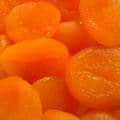The Role of Vitamin E
Vitamin E is known to have an important role in the all over health of the body. Some studies associate sufficient intake levels with the prevention of many serious health problems, and research still continues to delve into the many effects of this important nutrient. One thing that researchers do know for sure -- according to recent studies published by the United States Department of Agriculture -- most people do not consume the daily requirement of Vitamin E.Vitamin E protects Vitamin A in the body, allowing the A vitamin to perform its essential functions. Furthermore, Vitamin E is also one of the anti-oxidants that protects cells from damaging free radicals, which are waste products from the making of energy. Uncontrolled free radicals are believed to contribute to a variety of serious diseases, such as cardiovascular disease and some cancers. Vitamin E is also thought to have a role in DNA repair and in the body's natural immune system.
As many people are trying to reducing fats in their diets, they may unwittingly be reducing their daily intake of Vitamin E -- as Vitamin E is found in vegetable oils and nuts -- as it is in dark, leafy green vegetables.
Top 10 Foods Highest in Vitamin E
#1: Sunflower Seeds
 A great snack on the go, or a great garnish on salads and soups,
sunflower seeds provide 36.6mg (222% DV) of vitamin E in a 100g serving,
or 36.5mg (310% DV) per cup.
A great snack on the go, or a great garnish on salads and soups,
sunflower seeds provide 36.6mg (222% DV) of vitamin E in a 100g serving,
or 36.5mg (310% DV) per cup.#2: Paprika and Red Chili Powder
 It is nice to know you are able to add pepper to a dish whether mild (paprika) or spicy (red chili powder)
and get the same amount of vitamin E, around 30mg (199% DV) per 100g serving, or 2.1mg (14% DV) in a single tablespoon.
It is nice to know you are able to add pepper to a dish whether mild (paprika) or spicy (red chili powder)
and get the same amount of vitamin E, around 30mg (199% DV) per 100g serving, or 2.1mg (14% DV) in a single tablespoon.
#3: Almonds
 Almonds are best as a snack in raw whole form, but can also be found as almond butter and almond milk.
Almonds provide 26.2mg (175% DV) of vitamin E in a 100g serving, 37.5mg (250% DV) per cup,
and 0.3mg (2% DV) of vitamin E in an almond.
Almonds are best as a snack in raw whole form, but can also be found as almond butter and almond milk.
Almonds provide 26.2mg (175% DV) of vitamin E in a 100g serving, 37.5mg (250% DV) per cup,
and 0.3mg (2% DV) of vitamin E in an almond.
#4: Pine Nuts
 Known as a key component in pesto, pine nuts are also great on their own, or added to a fruit salad.
They provide 9.3mg (62% DV) of vitamin-E in a 100g serving, 12.6mg (84% DV) per cup, and 0.2mg (1% DV) in 10 nuts.
Known as a key component in pesto, pine nuts are also great on their own, or added to a fruit salad.
They provide 9.3mg (62% DV) of vitamin-E in a 100g serving, 12.6mg (84% DV) per cup, and 0.2mg (1% DV) in 10 nuts.
#5: Peanuts
 Most common in butter form, peanuts also make a great dry roasted unsalted snack, chop up a few as
a garnish to just about anything. A 100g serving will provide 6.9mg (46% DV) of vitamin E.
That is 10mg (67% DV) per cup, and 2mg (13% DV) per ounce.
Most common in butter form, peanuts also make a great dry roasted unsalted snack, chop up a few as
a garnish to just about anything. A 100g serving will provide 6.9mg (46% DV) of vitamin E.
That is 10mg (67% DV) per cup, and 2mg (13% DV) per ounce.
#6: Dried Herbs (Basil And Oregano)
 Basil and Oregano go a long way in pasta sauce and pizzas, but are also
great sprinkled on top of salads and sandwiches.
A 100g serving will provide 7.38mg (50% DV) of vitamin E, which is 0.2mg
(1% DV) per teaspoon. Other dried herbs high in vitamin E
include Sage, Thyme, Parsley, and Cumin.
Basil and Oregano go a long way in pasta sauce and pizzas, but are also
great sprinkled on top of salads and sandwiches.
A 100g serving will provide 7.38mg (50% DV) of vitamin E, which is 0.2mg
(1% DV) per teaspoon. Other dried herbs high in vitamin E
include Sage, Thyme, Parsley, and Cumin.
#7: Dried Apricots
 Most common as a snack, dried apricots can also be chopped and thrown into a fruit salad.
A good source of fiber
and many other vitamins, apricots also provide 4.3mg (29% DV) of vitamin E per 100g serving,
or 5.6mg (38% DV) per cup, and 0.2mg (2% DV) of vitamin E in half an apricot.
Most common as a snack, dried apricots can also be chopped and thrown into a fruit salad.
A good source of fiber
and many other vitamins, apricots also provide 4.3mg (29% DV) of vitamin E per 100g serving,
or 5.6mg (38% DV) per cup, and 0.2mg (2% DV) of vitamin E in half an apricot.
#8: Pickled Green Olives
 Olives have no end to culinary use, great in pasta sauce, pizzas, salads, or alone with bread, they will
provide 3.81mg (25% DV) of vitamin E in a 100g serving, 1.1mg (7% DV) per ounce (about 14 olives).
Olives have no end to culinary use, great in pasta sauce, pizzas, salads, or alone with bread, they will
provide 3.81mg (25% DV) of vitamin E in a 100g serving, 1.1mg (7% DV) per ounce (about 14 olives).
#9: Cooked Spinach
 Cooked spinach is great in stews, lasagnas, or as a side all by itself. It will provide
3.5mg (24% DV) of vitamin E in a 100g serving, 6.7mg (44% DV) per cup.
Cooked spinach is great in stews, lasagnas, or as a side all by itself. It will provide
3.5mg (24% DV) of vitamin E in a 100g serving, 6.7mg (44% DV) per cup.#10: Cooked Taro Root
 Inedible raw, taro is best baked, boiled, or incorporated into a bread.
Worth trying as a substitute for potato, taro root gives 2.9mg (10% DV) of vitamin E in a 100g
serving, 3.9mg (26% DV) in 1 cup sliced. It can be found in your local Asia market if not the grocery store.
Inedible raw, taro is best baked, boiled, or incorporated into a bread.
Worth trying as a substitute for potato, taro root gives 2.9mg (10% DV) of vitamin E in a 100g
serving, 3.9mg (26% DV) in 1 cup sliced. It can be found in your local Asia market if not the grocery store.

1 comment:
The green olives and cooked spinach are my best bets. Oh, and pecans,not listed. Good list for E. Keep them coming,Sharlotte.
Post a Comment